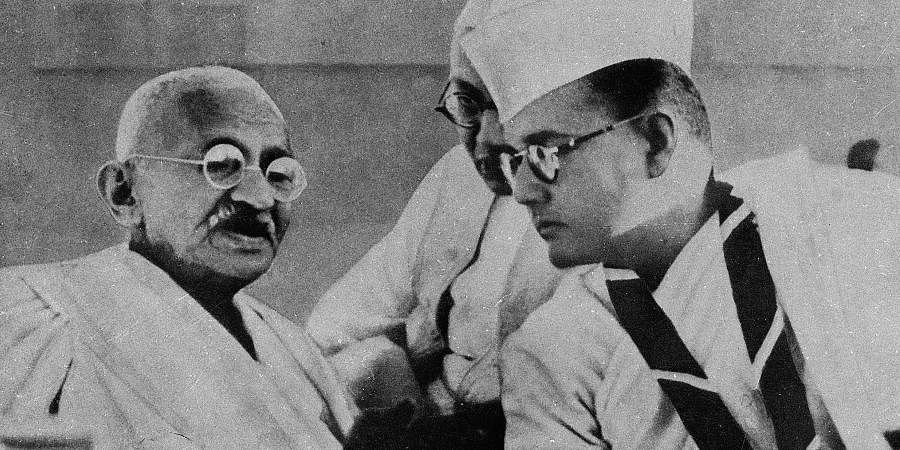I have always wanted the statue of King George on Rajpath to be replaced by one of Mahatma Gandhi, Father of the Nation. But now the BJP has decided to install a statue of Subhas Chandra Bose. This is a naked attempt by the BJP — which did not have a single prominent leader in the Independence movement — to try and appropriate Bose as a nationalist hero, downplaying the role of Gandhiji.
I was never a fan of Bose. He collaborated with two of the worst regimes in history — Hitler’s Nazis and Japan’s imperial thugs — that inflicted unspeakable horrors in World War II. Japan raped and murdered massively in its invasion of China and Burma and would have done the same in India given a chance. No amount of romanticisation can cloak the fact that Bose’s INA and its Japanese overlords were thrashed militarily. His Japanese allies killed hundreds of Indian soldiers.
Bose raised the Indian flag in the Andaman Islands after Japan occupied it. But historians like Aparna Vaidik have recorded that the outcome was not benevolent Indian rule but barbaric Japanese rule that the locals still shudder at. To think Japanese barbarism would be better than British rule — as Bose did — was barmy. Yet by getting Indian soldiers to mutiny, he made a significant contribution to Indian independence.
The British long said India could not be ruled against its will, meaning British rule was possible only by securing the loyalty of Indian troops, who constituted the overwhelming bulk of British forces. After the 1857 sepoy mutiny, the British were paranoid about getting wiped out by another mutiny. So, they doubled the ratio of British to Indian soldiers in the British Indian Army. But in World War 1, Britain needed soldiers galore, and so recruited a million Indians. Next in World War 2, the British recruited over two million Indian soldiers, and also trained Indian officers at Sandhurst. This meant a future mutiny would be led by quality officers, unlike the leaderless rebels of 1857.
I attended a seminar in 1967 on the 20th anniversary of independence, when Britain’s High Commissioner, John Freeman opined that Indian independence became irreversible after the Indian Naval Mutiny of 1946. I hadn’t heard of this event. Indian naval sailors staged a minor rebellion in Mumbai, but Sardar Patel pacified the mutineers saying independence was already being negotiated. The mutiny became a minor footnote in history. Nevertheless, said Freeman, the mutiny proved Britain had lost the loyalty of Indian troops, making its overlordship impossible. Bose was dead by then, but the mutiny he started lived on, so the British preferred to exit gracefully.
Narendra Modi has already had some success in appropriating Sardar Patel to the BJP pantheon by building a massive Patel statue overlooking the Sardar Sarovar Dam. The Congress castigated the statue as wasteful expenditure, a terrible strategy that played into Modi’s hands. Instead, it should have promised to build a grand Patel Museum at the site that would highlight his secular commitment and emphasis on communal harmony.
The Congress must not repeat its mistake in the case of Bose’s statue. Opposing the statue will be politically silly, and help Modi appropriate a bit of Bose’s strong-leader legacy. Instead, the Congress should launch a campaign to popularise Bose’s own secular sentiments, and emphasise how these are dead opposed to BJP values. That of course also implies the Congress must abandon the soft Hindu line it has foolishly chosen and return to the hard secularism of Bose.
Historian Ramchandra Guha says Bose was utterly contemptuous of the communalism of the Hindu Mahasabha and made communal unity the central culture of his Indian National Army. He named his four brigades after Gandhi, Nehru, Maulana Azad and himself. In his vernacular translation of ‘Indian National Army’, he used three Urdu words, ‘Azad Hind Fauj’. He declined to use a Hindi translation, which would have been ‘Swatantra Bharat Sena’. Contemporaries say he spoke Urdu better than English.
For his top military leaders, he chose Sehgal (a Hindu), Dhillon (a Sikh) and Shahnawaz Khan (a Muslim), to exemplify communal unity. These values were utterly opposed to Savarkar’s Hindutva.
A day will come when another party or alliance is in office at the Centre. When that happens, the new government must inscribe all Bose’s secular sentiments in carved letters on the new monument the BJP is building. These should include Bose’s admiring comments on Gandhi and Nehru, notwithstanding their differences. The BJP will be upended by this tactic yet will not dare deface the monument by erasing those words should it return to power. That is the way secular parties can re-appropriate Bose.
This article was originally published in The Times of India on January 29, 2022.


